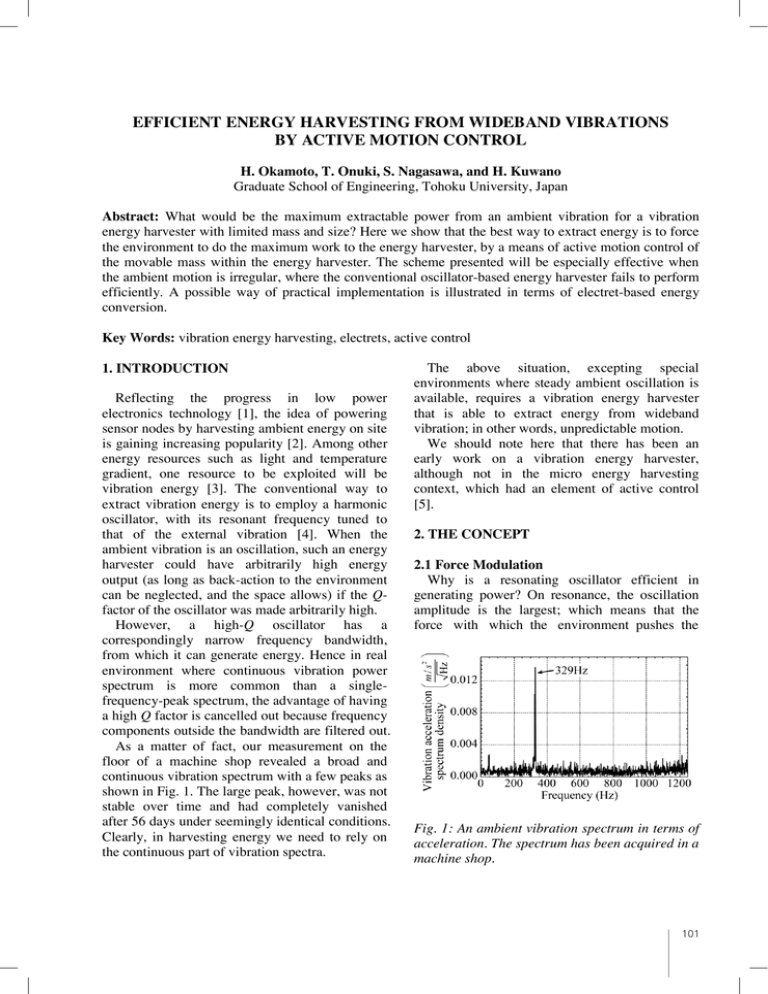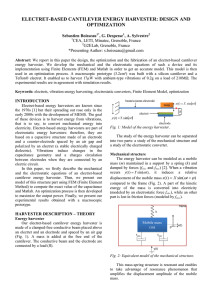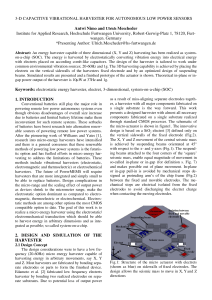EFFICIENT ENERGY HARVESTING FROM WIDEBAND VIBRATIONS BY ACTIVE MOTION CONTROL
advertisement

EFFICIENT ENERGY HARVESTING FROM WIDEBAND VIBRATIONS BY ACTIVE MOTION CONTROL H. Okamoto, T. Onuki, S. Nagasawa, and H. Kuwano Graduate School of Engineering, Tohoku University, Japan Abstract: What would be the maximum extractable power from an ambient vibration for a vibration energy harvester with limited mass and size? Here we show that the best way to extract energy is to force the environment to do the maximum work to the energy harvester, by a means of active motion control of the movable mass within the energy harvester. The scheme presented will be especially effective when the ambient motion is irregular, where the conventional oscillator-based energy harvester fails to perform efficiently. A possible way of practical implementation is illustrated in terms of electret-based energy conversion. Key Words: vibration energy harvesting, electrets, active control 1. INTRODUCTION Reflecting the progress in low power electronics technology [1], the idea of powering sensor nodes by harvesting ambient energy on site is gaining increasing popularity [2]. Among other energy resources such as light and temperature gradient, one resource to be exploited will be vibration energy [3]. The conventional way to extract vibration energy is to employ a harmonic oscillator, with its resonant frequency tuned to that of the external vibration [4]. When the ambient vibration is an oscillation, such an energy harvester could have arbitrarily high energy output (as long as back-action to the environment can be neglected, and the space allows) if the Qfactor of the oscillator was made arbitrarily high. However, a high-Q oscillator has a correspondingly narrow frequency bandwidth, from which it can generate energy. Hence in real environment where continuous vibration power spectrum is more common than a singlefrequency-peak spectrum, the advantage of having a high Q factor is cancelled out because frequency components outside the bandwidth are filtered out. As a matter of fact, our measurement on the floor of a machine shop revealed a broad and continuous vibration spectrum with a few peaks as shown in Fig. 1. The large peak, however, was not stable over time and had completely vanished after 56 days under seemingly identical conditions. Clearly, in harvesting energy we need to rely on the continuous part of vibration spectra. The above situation, excepting special environments where steady ambient oscillation is available, requires a vibration energy harvester that is able to extract energy from wideband vibration; in other words, unpredictable motion. We should note here that there has been an early work on a vibration energy harvester, although not in the micro energy harvesting context, which had an element of active control [5]. 2. THE CONCEPT 2.1 Force Modulation Why is a resonating oscillator efficient in generating power? On resonance, the oscillation amplitude is the largest; which means that the force with which the environment pushes the Fig. 1: An ambient vibration spectrum in terms of acceleration. The spectrum has been acquired in a machine shop. 101 energy harvester is the largest because the internal proof mass puts up resistance by maximally pulling the spring. However, off the resonance the motions of the external vibration and the proof mass no longer synchronize, and actually the proof mass occasionally helps the external motion, that is, giving energy back to the environment. In our proposed scheme we intend to utilize the advantage of a resonating oscillator, that is to maximize the interaction force with the environment. At the same time, we intend to avoid the loss of synchronicity off the resonance. In order to achieve this, the motion of the internal mass element (IME) should be controlled in a way that its motion is deliberately made synchronous with the external motion, no matter how irregular it may be. The external motion can be monitored with a standard accelerometer. In more formal terms, the power P that flows into the energy harvester from the environment is given by 𝑑𝑑𝑠𝑠 𝑃𝑃 = 𝐹𝐹 𝑑𝑑𝑡𝑡 = 𝐹𝐹𝑣𝑣 (1) where F is force between the environment and the energy harvester, ds is a length over which the energy harvester moves during a time period dt, and hence 𝑣𝑣 is velocity of the energy harvester (not of the IME). This relation holds generally. We would like to maximize P by controlling F. The force F can be generated by pushing the IME with force F by an actuator fixed to the energy harvester. It should be evident from Eq. (1) that it is better to keep the signs of F and 𝑣𝑣 to be the same, in order not to release energy back to the environment. In a resonating oscillator, to a good approximation F is proportional to 𝑣𝑣. Therefore, a natural choice of the motion control would be to do the same: That is, to apply force F, which is proportional to the velocity 𝑣𝑣 of the energy harvester, to the IME through the actuator. This control protocol shall be referred to as proportional control hereafter. The velocity 𝑣𝑣 may be obtained by integrating the output of the accelerometer fixed to the energy harvester. Naturally, this protocol keeps the sign of 𝐹𝐹𝑣𝑣 product unchanged. 102 2.2 Control Circuit The circuit and actuator that controls IME motion requires special consideration for our scheme to work. For instance, ordinary actuators may consist of a piezoelectric element and a highvoltage control circuit. Usually, a high voltage amplifier controls its output voltage via feedback control. As such, when the piezoelectric element is generating power, or equivalently a current is flowing out of it to charge associated (likely parasitic) capacitance, the high voltage amplifier would detect the voltage increase and lower the output voltage accordingly. The result would be total dissipation of the generated energy. What we need here is a control circuit that is capable of both sourcing and capturing energy depending on the direction of the current flow while keeping desired voltage output as specified by, for example, the proportional control protocol mentioned above. The circuit must contain an energy storage that exchanges energy bidirectionally with the actuator. The final power output from the system should be taken from the excess amount in the energy storage. Although it may appear to be difficult to design a circuit satisfying these criteria even in principle, a basic scheme to build such a circuit is shown in the next section. 3. POSSIBLE IMPLEMENTATION STRATEGY USING AN ELECTRET 3.1 Energy Conversion by an Electret An electret is an insulator that retains surface charge up to 10-3 C/m2 [6]. Electrets have recently been employed in the context of micro vibration energy harvesting [7]. The physical principle of power generation using the electret is straightforward. As the surface of an electret is charged, when it is placed near a larger piece of metal, opposite charge is induced on the surface of the metal near the electret. When the electret moves, the induced charge tracks the movement, resulting in an electric current inside the metal (in this case causing Joule heating). Figure 2 shows how to get this current to an outside load or circuit. The hatched portion represents a positively charged electret film. Fig. 2: Principle of vibration energy harvesting using an electret. The type of electromechanical converter shown here extracts energy from horizontal ambient vibration. The system shown in Fig. 2 can also be regarded as an actuator, since voltage difference between the two metallic electrode located underneath generates a force on the IME that is proportional to the voltage because of electrostatic interaction. 3.2 Control Circuit Design Suppose that the IME shown in Fig. 2 moves freely with negligible mechanical friction. As mentioned above, the control circuit must generate a desired voltage while allowing energy to flow in either direction between the electromechanical converter and the circuit. A way to contrive such a circuit is briefly as follows (a more complete explanation will appear elsewhere [8]). First of all, note that if the output voltage were fixed, simply a large capacitor would do, because small difference in the charge content affects the voltage negligibly. In this case, the capacitor also plays the role of energy storage. To generate a variable voltage, one can use multiple (possibly many) charged capacitors in series, along with a network of electrically controllable switches (perhaps consisting of FETs). Figure 3 shows a scheme of such a circuit. For the sake of simplicity, only 3 capacitors are shown. The Aswitches are used to bypass discharged capacitors. Only one of all the B-switches are closed, where one end of the series of charged capacitors is grounded in order to generate a desired voltage. More detailed quantitative analysis appears to show that, by using sufficiently segmented electret strips, it is possible to design a reasonably small electret-based electromechanical converter that is amenable to electrical motion control [8]. 4. A PROTOCOL BEYOND THE PROPORTIONAL CONTROL Equation (1) indicates that the larger the force F, the larger the output power. However, the use of large force F, or equivalently a large proportional constant of the proportional control, would evidently result in a long IME travel length required. Since the size of an energy harvester is limited, a compromise has to be struck. On the other hand, it is almost exclusively the low-frequency component of the ambient vibration that demands the long travel length. Hence, it would make sense to increase sensitivity to higher frequency vibrations in order to enhance power output without sacrificing the size of the energy harvester. There should be many ways to do so. One way would be to modify proportional control so that it would be more sensitive to high frequencies, that is, instead of 𝐹𝐹 ∝ 𝑣𝑣 , we may employ 𝐹𝐹 ∝ 𝑣𝑣 + 𝛼𝛼𝑣𝑣 3 Fig. 3: Basic scheme of the control circuit. (2) where 𝛼𝛼 is a constant. According to our simulation study [8], the inclusion of nonlinear term indeed enhanced the power output as shown 103 the other hand, energy consumption by the control circuit is relatively small for a larger energy harvester and the scheme presented here may well be immediately applicable there already. ACKNOWLEDGMENT This work was supported by the Japanese Ministry of Education, Culture, Sports, Science and Technology in Japan, Grant-in-Aid for Creative Scientific Research (18GS0203). REFERENCES Fig. 4: Effect of a nonlinear control protocol on the power output. in Fig. 4. The parameters 𝛾𝛾 and 𝜌𝜌 in Fig. 4 are dimensionless parameters that represents power output P and the non-linearity coefficient 𝛼𝛼 , respectively. When 𝛼𝛼 is not too large, it has been found that the increase of power generation efficiency was associated with a very modest increase in the travel length of the IME. 5. CONCLUSION We presented a scheme of vibration energy harvester that employs active motion control of an internal mass. When one shakes such a machine, the machine resists the motion by moving its internal mass in a way that the shaker feels ‘viscous’ force. The maximum work the shaker is forced to do in this way is converted to the output electric power. Implementation of such an active method will require a rather complex control circuit. This has been described in terms of a design involving an electret-based electromechanical power converter. Despite the complexity of the circuit, it is our belief that progress in low-power electronics will eventually allow us to realize such a circuit, and hence discussions about actively controlled energy harvester begins to make sense now. On 104 [1] See e. g., E. A. Vittoz, Low-power design: ways to approach the limits, in Proc. IEEE. Int. Solid State Circuits Dig. Tech. Papers, San Francisco, USA, Feb., 1994, pp. 14-18. [2] See e. g., J. A. Paradiso and T. Starner, Energy Scavenging for Mobile and Wireless Electronics, Pervasive Computing, Jan.-Mar., pp. 18-27, 2005. [3] S. Roundy, P. K. Wright and J. Rabaey, A study of low level vibrations as a power source for wireless sensor nodes, Computer Communications, vol. 26, pp. 1131-1144, 2003. [4] C. B. Williams and R. B. Yates, Analysis of a micro-electric generator for microsystems, Sensors and Actuators, vol. A52, pp. 8-11, 1996. [5] K. Sasaki, Y. Osaki, J. Okazaki, H. Hosaka, and K. Itao, Vibration-based automatic power generation system, Microsyst. Technol., vol. 11, pp. 965-969, 2005. [6] M. Eguchi, On the Permanent Electret, Phil. Mag. vol. 49, pp. 178, 1925. [7] T. Tsutsumino, Y. Suzuki, N. Kasagi, K. Kashiwagi, and Y. Morizawa, Efficiency Evaluation of Micro Seismic Electret Power Generator, in Proc. 23rd Sensor Symp. Takamatsu, Japan, 2006, pp. 521-524, 2006. [8] H. Okamoto, T. Onuki, S. Nagasawa, and H. Kuwano, preprint.




